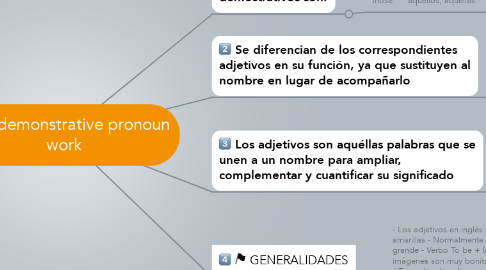How demonstrative pronoun work
por heinar arnulfo turcios ortega


1. Los pronombres demostrativos son:
1.1. · this éste, esto, ésta · that aquél, aquello, aquella, eso, ésa · these éstos, éstas · those aquéllos, aquéllas
2. Se diferencian de los correspondientes adjetivos en su función, ya que sustituyen al nombre en lugar de acompañarlo
2.1. She drives that car / Ella conduce ese coche ('that' hace las funciones de adjetivo) That is her car / Ese es su coche ('that' hace las funciones de pronombre) · such tal, tales Why have they done such a thing? / ¿Por qué han hecho tal cosa? · none ninguno, ninguna None of the guests want to stay / Ninguno de los invitados quiere quedarse. · one, ones carecen de un significado específico. Su función es reemplazar a los sustantivos para evitar su repetición. That is my house. The white one / Esa es mi casa. Es la blanca
2.1.1. Determine Next Stage Tasks
2.1.2. Determine Task Dependencies
2.1.3. Estimate Effort
2.1.4. Allocate Resources
2.1.5. Prepare Next Stage Schedule
2.1.6. Prepare Next Stage Budget
2.1.7. Update Project Schedule
2.1.8. Update Project Budget
2.1.9. Review Business Case
2.1.10. Review Project Organization
2.1.11. Review Project Scope
2.1.12. Prepare Stage Assessment
2.1.13. Review Stage Assessment
2.1.14. Follow-Up Stage Assessment
2.1.15. Compile Stage Closure Report
3. Los adjetivos son aquéllas palabras que se unen a un nombre para ampliar, complementar y cuantificar su significado
3.1. En inglés hay ocho clases de adjetivos: 1. Calificativos: good, bueno; thin, delgado; dry, seco; bad, malo; short, corto 2. Demostrativos: this, este; that, aquel; these, estos; those, aquellos 3. Distributivos: each, cada; every, todo; either, uno y otro; neither, ni uno ni otro. 4. De cantidad: some, algún; any, cualquier; little, poco; few, pocos; many,muchos; much, mucho; enough, bastante 5. Interrogativos: which?, cual?; what?, ¿qué?; whose?, ¿de quién?, etc. 6. Posesivos: my, mi; your, tu, su, vuestro, his, su (de él); her, su (de ella); its, su (de ello), our, nuestro; your, vuestro, their, suyo (de ellos/as) 7. Propios: French, francés; English, inglés; Spanish, español; etc. 8. Numerales: one, uno; ten, diez; first, primer, second, segundo; etc.
3.1.1. Prepare Project Review
3.1.2. Conduct Project Review
3.1.3. Implement Process Improvement
